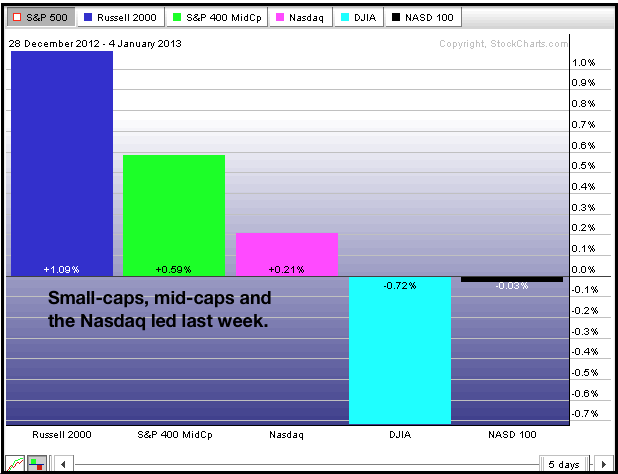Stocks took a big bite of risk to start the year. Last week's gains were split between years with the surge starting on December 31st and continuing on January 2nd. Stocks consolidated the last two days of the week and held on to their gains. The return to risk can be seen in major index PerfChart below. Notice that the Russell 2000 ($RUT), S&P MidCap 400 ($MID) and Nasdaq outperformed the S&P 500 since December 28th, while the Dow Industrials and Nasdaq 100 ($NDX) underperformed. Relative strength in small and mid caps is positive because these are higher beta (riskier) stocks with closer ties to the domestic economy. A vote for the little guys is a vote of confidence in the economy.


Fundamentally, we have a relatively quiet week or two before earnings season hits (21-January). The economic docket is slow and there are just a handful of earnings reports this week. Last week's economic numbers were positive overall and support the long-term uptrend in stocks. Construction spending and Factory Orders fell short of expectations, but the ISM Manufacturing Index and ISM Services Index beat expectations. Both ISM indices were above 50, which indicates economic expansion. Non-farm payrolls expanded by 155,000, which was pretty much in line with expectations and the 12-month average. The employment report may not have been great, but it certainly wasn't negative.



**************************************************************************

**************************************************************************

**************************************************************************

**************************************************************************

**************************************************************************
Key Reports and Events:
Wed - Jan 09 - 07:00 - MBA Mortgage Index
Wed - Jan 09 - 10:30 – Oil Inventories
Thu - Jan 10 - 08:30 - Jobless Claims
Thu - Jan 10 - 10:30 - Natural Gas Inventories
Charts of Interest: Tuesday and Thursday
This commentary and charts-of-interest are designed to stimulate thinking. This analysis is
not a recommendation to buy, sell, hold or sell short any security (stock ETF or otherwise).
We all need to think for ourselves when it comes to trading our own accounts. First, it is
the only way to really learn. Second, we are the only ones responsible for our decisions.
Think of these charts as food for further analysis. Before making a trade, it is important
to have a plan. Plan the trade and trade the plan. Among other things, this includes setting
a trigger level, a target area and a stop-loss level. It is also important to plan for three
possible price movements: advance, decline or sideways. Have a plan for all three scenarios
BEFORE making the trade. Consider possible holding times. And finally, look at overall market
conditions and sector/industry performance.



**************************************************************************

**************************************************************************

**************************************************************************

**************************************************************************

**************************************************************************
Key Reports and Events:
Wed - Jan 09 - 07:00 - MBA Mortgage Index
Wed - Jan 09 - 10:30 – Oil Inventories
Thu - Jan 10 - 08:30 - Jobless Claims
Thu - Jan 10 - 10:30 - Natural Gas Inventories
Charts of Interest: Tuesday and Thursday
This commentary and charts-of-interest are designed to stimulate thinking. This analysis is
not a recommendation to buy, sell, hold or sell short any security (stock ETF or otherwise).
We all need to think for ourselves when it comes to trading our own accounts. First, it is
the only way to really learn. Second, we are the only ones responsible for our decisions.
Think of these charts as food for further analysis. Before making a trade, it is important
to have a plan. Plan the trade and trade the plan. Among other things, this includes setting
a trigger level, a target area and a stop-loss level. It is also important to plan for three
possible price movements: advance, decline or sideways. Have a plan for all three scenarios
BEFORE making the trade. Consider possible holding times. And finally, look at overall market
conditions and sector/industry performance.

About the author:
Arthur Hill, CMT, is the Chief Technical Strategist at TrendInvestorPro.com. Focusing predominantly on US equities and ETFs, his systematic approach of identifying trend, finding signals within the trend, and setting key price levels has made him an esteemed market technician. Arthur has written articles for numerous financial publications including Barrons and Stocks & Commodities Magazine. In addition to his Chartered Market Technician (CMT) designation, he holds an MBA from the Cass Business School at City University in London.
Learn More